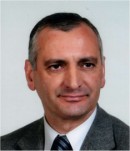
Plenary Lecture
Nonlinear Effects in Optical Fiber Transmission Systems

Professor Mário F. S. Ferreira
I3N – Institute of Nanostructures, Nanomodelling and Nanofabrication
Department of Physics
University of Aveiro
Portugal
E-mail: mfernando@ua.p
Abstract: Nonlinear effects in optical fibers impose different limitations on the communications link, and an understanding of such effects is almost a prerequisite for actual lightwave-system designers. On the other hand, they offer a variety of possibilities for all-optical signal processing, amplification and regeneration. Using conventional optical fibers for these applications, a length of several kilometres is usually required due to their relatively small nonlinear parameter ( ). Such long fibers pose some practical limitations, concerned namely with the size and stability of the system. The required fiber length is reduced to about 1km using highly nonlinear silica fibers with a smaller effective mode area, and hence, a larger nonlinear parameter ( ). A further reduction in fiber length by one order of magnitude has been achieved in recent years using nanowires and microstructured optical fibers with an extremely small effective mode area and significantly enhanced nonlinear characteristics. Another main advance was the production of highly nonlinear fibers using materials with a nonlinear refractive index higher than that of the silica glass, namely lead silicate, tellurite, bismuth glasses and chalcogenide glasses. Using such fibers, the required fiber length for nonlinear processing can be dramatically reduced to the order of centimetres. In this paper we review the effects – both detrimental and potentially beneficial – of optical nonlinearities both in conventional and in highly nonlinear fibers.
Brief Biography of the Speaker: Mário F. S. Ferreira was born in Ovar, Portugal. He graduated in Physics from the University of Porto, Portugal, and he received the Ph.D. degree in Physics in 1992 from the University of Aveiro, Portugal, where he is now a Professor at the Physics Department.Between 1990 and 1991 he was at the University of Essex, UK, performing experimental work on external cavity semiconductor lasers and nonlinear optical fiber amplifiers. His research interests have been concerned with the modeling and characterization of multi-section semiconductor lasers for coherent systems, quantum well lasers, optical fiber amplifiers and lasers, soliton propagation, nanophotonics, polarization and nonlinear effects in optical fibers. He is actually the leader of the Optics and Optoelectronics Group of the I3N – Institute of Nanostructures, Nanomodelling and Nanofabrication. He has written more than 300 scientific journal and conference publications, and three books: “Optics and Photonics” (Lidel, 2003, in Portuguese); “Nonlinear Effects in Optical Fibers” (Wiley & OSA, 2011), and “Topics on Mathematical Physics “ (Editora Ciência Moderna Ltda., Brazil, 2015, in Portuguese). He is a member of the Optical Society of America (OSA), SPIE - The International Society for Optical and Photonics, and the Portuguese Physical Society. He is a Travelling Lecturer of SPIE. He served in various committees of the OSA and SPIE, having been also a member of the Telecommunications Committee of the “International Association of Science and Technology for Development” (IASTED). He served also in the technical committees of various international conferences. He is the General Chair of the conference on “Optical Sensors”, part of “OSA Optics and Photonics Congress", Boston, MA, USA, June 27 June to July 1, 2015. He served as a reviewer of several scientific journals in the area of optics and optoelectronics. He is presently an Associate Editor of “Optical Fiber Technology- Materials, Devices, and Systems” (Elsevier) and a member of the Advisory Board of “Fiber and Integrated Optics” (Taylor & Francis), “Nonlinear Optics, Quantum Optics” (Old City Publishing, Inc.), “Journal of Optics and Photonics” (Herbert Publications), and “International Journal of Optics” (Hindawi Publishing Corporation). He was the Guest Editor of the Special Issue “Fiber and Integrated Optics: Fiber Optics in Portugal” (Taylor & Francis, Philadelphia, PA, USA), Vol. 24, Nº 3-4, 2005. He is the Guest Editor of a Special Issue of “Fiber and Integrated Optics” (Taylor & Francis, Philadelphia, PA, USA), dedicated to: Nonlinear Fiber Optics (2015)..